Auctioning Fashion: A Conversation with Kerry Taylor on Peggy Moffitt, Rudi Gernreich, and more
If you are interested in vintage fashion, you likely know the name Kerry Taylor. As the owner of a world-renowned auction house devoted to vintage and antique clothing and textiles, Kerry has been a major force in making vintage fashion into the prized, highly collectible market it is today. When she started at Sotheby’s in 1980, and for many decades after, collecting vintage and antique clothes was the province of a small, specialized group of collectors. Even when I first started purchasing from Kerry Taylor Auctions and first met her, twenty years ago, the market was a very different place. For 45 years, she has stuck with it, pouring all of her passion into auctions, breaking records over and over again, igniting a global interest in collecting beautiful garments, which has found its way into record-breaking museum exhibitions and onto the red carpet.
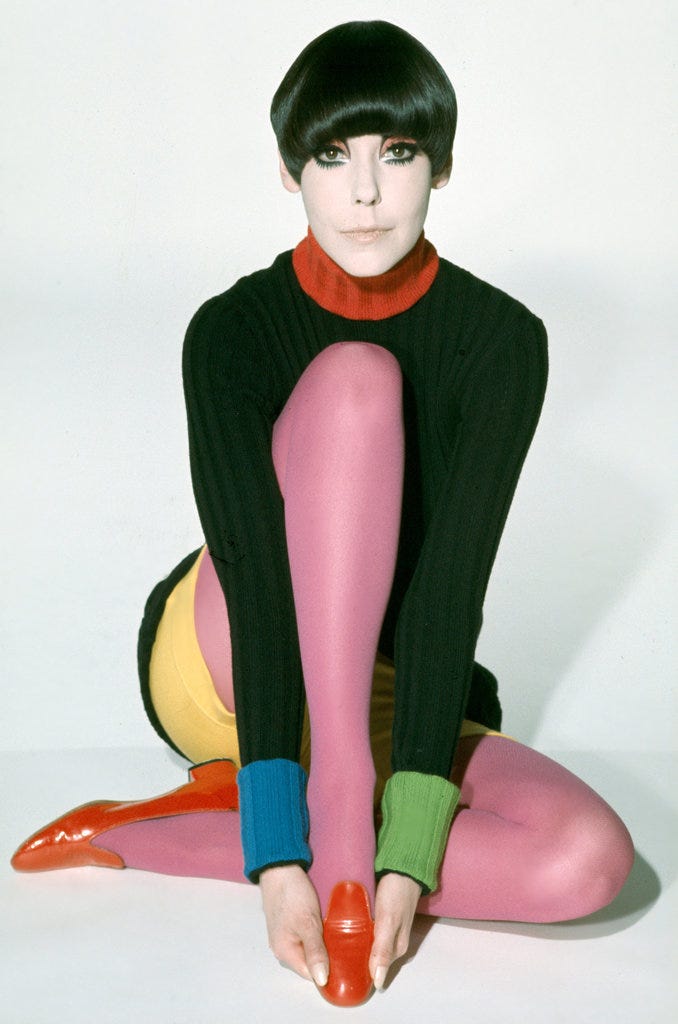
For a good overview of some of the many incredible pieces she’s sold and auction records she’s broken, read this history on the Kerry Taylor Auctions website.
Now, Kerry Taylor is expanding to the United States, opening a second showroom (the first is in Bermondsey, London) in Jersey City, right over the river from downtown Manhattan. Taking place today, Kerry Taylor Auctions is auctioning the estate of the iconic model Peggy Moffitt. As the muse to designer Rudi Gernreich and wife to photographer William Claxton, the three of them were responsible for some of the most famous, most innovative fashion images of the 1960s. Her collection—almost entirely made up of pieces by Rudi Gernreich, most of which she was photographed in—is remarkable. Looking through the rails in Kerry Taylor’s showroom, or through the online catalogues, one is struck by just how modern Gernreich’s designs are. In the 1960s, many were shocking (especially the Monokini) and avant-garde, with his innovative ideas forcibly pushing the fashion world forward. Their impact trickled down through all levels of the industry, particularly in his use of comfortable, easy-to-wear and move in knits.
This afternoon, May 21, 2025, at 2 pm EST, Kerry will be holding a live auction of half of the collection—the most famous and desirable pieces. You can view the catalogue and bid online here.
Bidding for the online-only portion of the collection ends tomorrow, May 22, 2025, at 12 pm EST. You can view the catalogue and bid online here.
I highly recommend visiting the Kerry Taylor Auctions website and signing up for their newsletter to keep informed about upcoming auctions. Kerry and her team do an incredible amount of research about each lot in each auction, and the newsletters are a wonderful romp through the history of textiles and dress. If you are in London or New York around the time of an auction, KTA is always open for viewings the few days before—definitely worth a visit to see and touch icons of fashion history.
Below is a conversation I had with Kerry yesterday, where she walked me through Peggy’s collection and spoke to me about Kerry Taylor Auction’s new American location.
This interview has been edited and condensed for clarity.
Kerry Taylor: This costume, this bathing suit—which is obviously topless—this is what really made, really launched the careers of Peggy Moffitt and Rudi Gernreich. Rudi Gernreich designed this in 1964. In 1962, he predicted that within five years, there would be topless bathing suits for women. Then in 1964, Emilio Pucci said the same thing. There was one thing that Rudi Gernreich hated. It was being beaten. He wanted to be first at everything always. To be fair, he usually was. He was always ahead of his time.
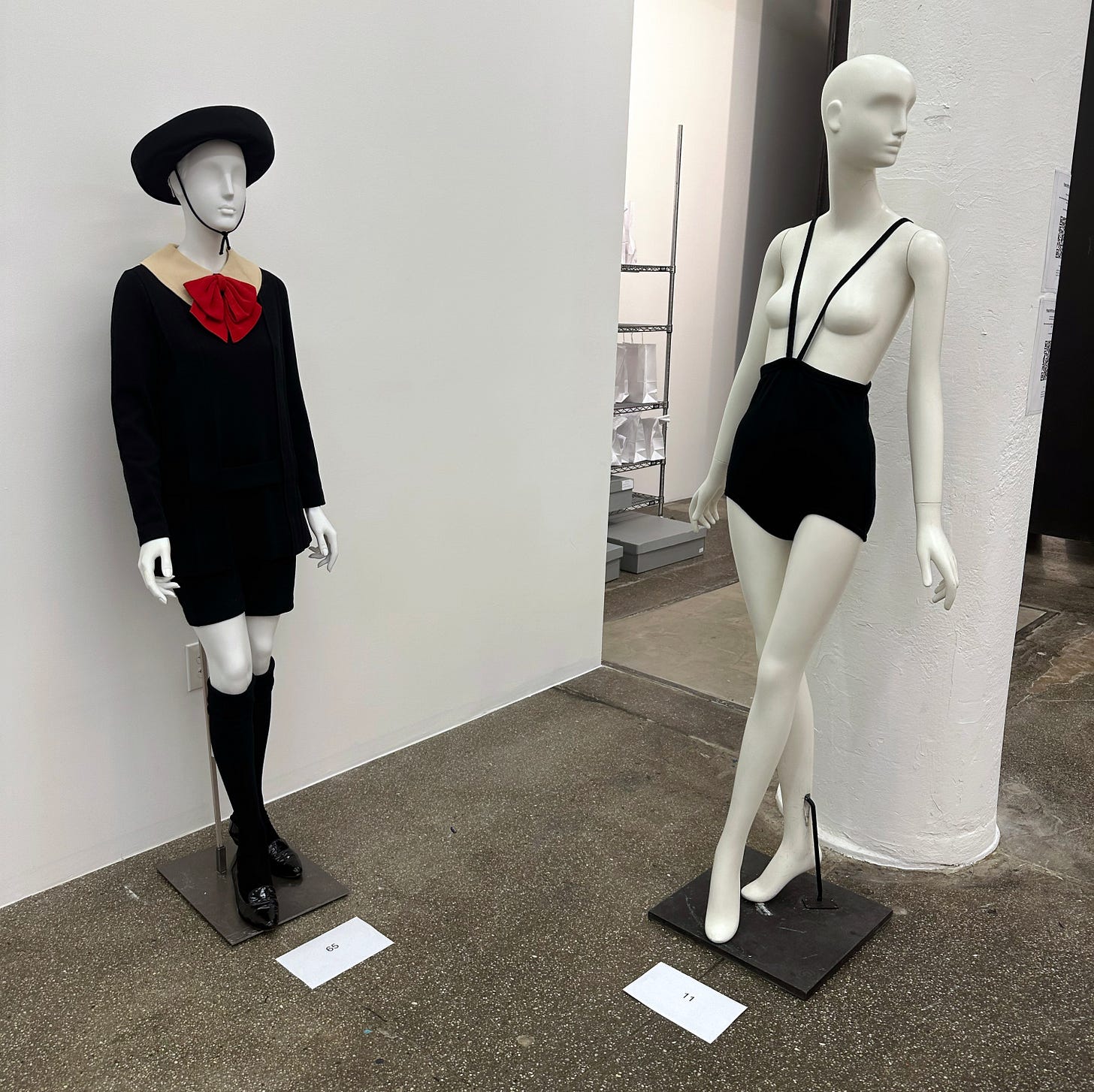
Lord & Taylor thought this was a cool, fun idea. They initially placed an order for about 3,000. Anyway, he dressed up Peggy Moffitt. She wore this and she wore a kimono. He went to see Diana Vreeland. Diana Vreeland was very taken with the kimono that she was wearing, which had nothing to do with Rudi Gernreich or anything. Then Rudi said, "No, take it off." She took off. There she was in all her magnificence. Because it has to be said, Peggy Moffitt had the most beautiful pert breasts ever. The most gorgeous figure. Beautiful, absolutely beautiful.
Initially, she’d refused to model this, because when he showed it to her, she said, "Oh my goodness, who's going to model that?" He said, "Well, you are." She said, "Ohhhh, I'm not." It took him a month of persuasion. She agreed with the proviso that her husband would take her photograph, she wouldn't wear it in public, and that she would have a say where the photograph was published. Bill Claxton took this beautiful photograph of her, which has really come to capture that moment of sexual emancipation in the swinging '60s and female freedom as well.
Peggy very much saw this as a political statement. She said, "If we free the breasts, people are not going to be able to slather over them and use them in adverts anymore, because they're just breasts. Get over it, men." Unfortunately, the world is how it is and that really didn't happen, and I think she was slightly naive to think that that would happen. I think Rudi knew this was going to be a press moment, which could make or break him. As I say, the two of them, it launched their career.
Back to Diana Vreeland… Diana Vreeland sees the swimsuit on Peggy and she says, "Oh, it's marvelous, marvelous." He says, "Yes, but I don't think we're going to make it because Lord & Taylor have cancelled their order, and since the photograph was released, the Kremlin has denounced it as a symbol of American decadence. The Vatican has denounced it. The Greek and the Danish governments had even come out and forced to say, ‘This is outrageous.’” In fact, in conservative America, in conservative times as they were, it was this sort of youth movement of freedom versus the old guard. Anyway, she convinced him, she said, "You've done it now, you cannot go back on it. You have to make it."
Good old Harmon Knitwear, with whom he'd been working since the late '50s, agreed to make the swimsuit. It's this really quite heavy wool. By modern standards, we would not say this is sexy. It's cut very low on the leg. It looks like the sort of thing like a little three-year-old toddler would wear, to be honest. Of course, on Peggy, it looks amazing. To our modern mindset, we say, “what is the fuss about?” But it was a moment. So a swimsuit that's a feminist statement, that shocked the world in 1964. The only magazine or periodical that would publish the photograph of Peggy with her breasts—Women's Wear Daily published it. Bill Claxton had to take more photographs of Peggy from the back, Peggy with her arms up, Peggy doing everything except showing what the whole point of the costume was. Peggy said she loved that photograph and she was very dismissive of people who wanted the more coy versions of it.
Interestingly, this time when Women's Wear Daily were very kind enough to cover my auction, they didn't use the photograph. Maybe it's too shocking, the picture of Peggy with her perfect breasts, it's too shocking for modern America. What does that say about American women at this point?
Laura McLaws Helms: There's a lot that could be said about what's going on in America right now…
Kerry: It's quite interesting, isn't it? Now over here, we've got these rather bizarre but rather wonderful outfits. These are both from the first ever fashion video ever made really, which is called Basic Black, which was made in 1967 by Peggy's husband, Bill Claxton, using Rudi's clothes, and with Peggy basically as a performance artist with two other models—they don't model the clothes, they do perform the clothes.
The one on the left is an extraordinary outfit. It's printed hide, printed with tiger stripes. It's got a sort of balaclava-like hood. It's got an underdress. It's got a jacket with—they're like big teddy bear eye buttons. It's got a very short skirt. It's got three pairs of tights. It's got a pair of matching shoes. It's got a pair of matching gloves. It's even got matching bra and knickers. Again, Rudi was very much ahead of his time in the sense that the total look, which is something he really believed in. He was one of the first ever to do head-to-toe. The one on the right is a crazy thing, which is a dress and matching tights and a headdress made from peacock feathers. It's the peacock dress, basically. I love it.
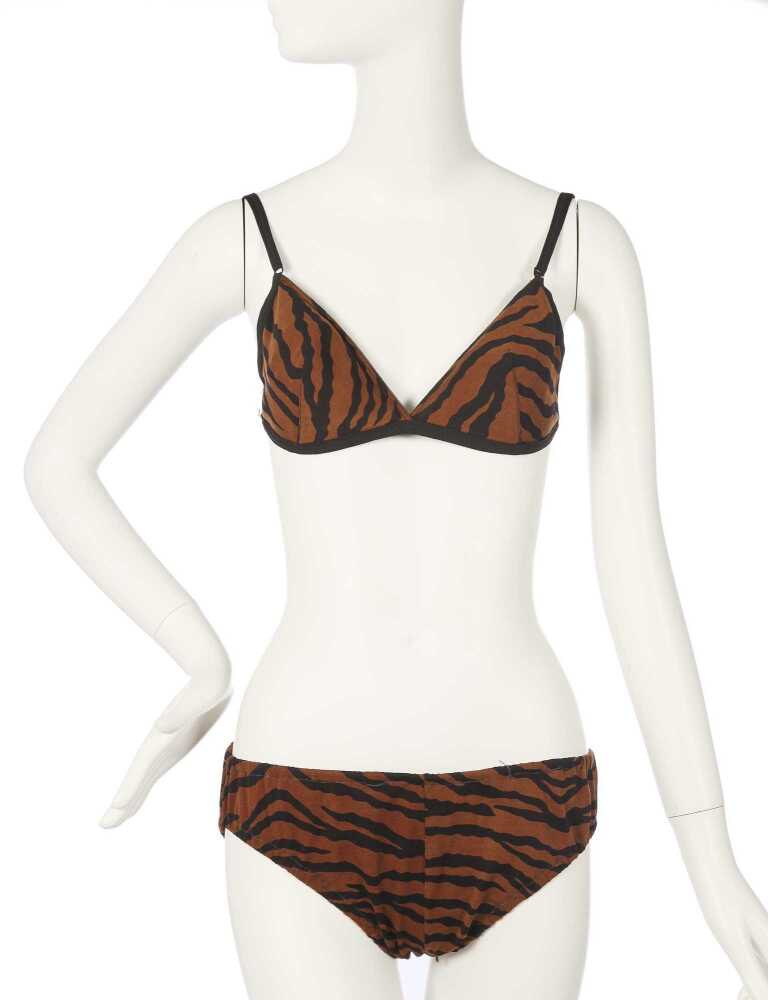
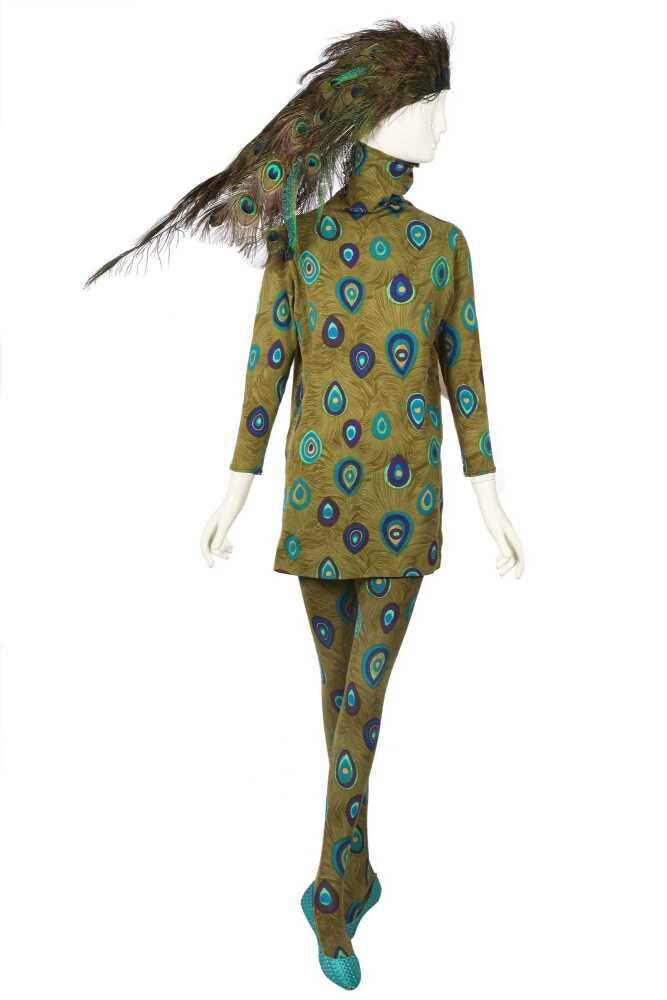
The one in the center is of ivory jersey. This is very space age. This is 1967. This particular model appeared on the cover of Time magazine, where Gernreich was described as the leading American designer of that time. What was happening in Paris with Pierre Cardin and Courrèges, in London with John Bates, here in America, we have Rudi Gernreich going full out space age. You have this wonderful mini dress, which is intersected with horizontal bands of clear vinyl, with matching booties—and that also comes with a matching bikini.
Laura: I love the fact that she still had all of the elements together, that she hadn't lost any of the matching pieces.
Kerry: I think it's true to say that Rudi Gernreich's pieces are timeless. It's actually proven by the point that Peggy Moffitt was wearing his designs in the late '50s, and she was still wearing them in 2024 when she was 86. This is all she ever wore, pretty much. She always wore her Gernreich wardrobe, which is hundreds and hundreds of pieces—she had no need ever to go shopping, apart from the basics like socks and underwear. She never needed to change her wardrobe. Interestingly—apart from, unfortunately, some moth damage, because a lot of the things are made in this lovely knitted wool jersey—they're in good condition.
Laura: I've always loved these [floral silk] fabrics.
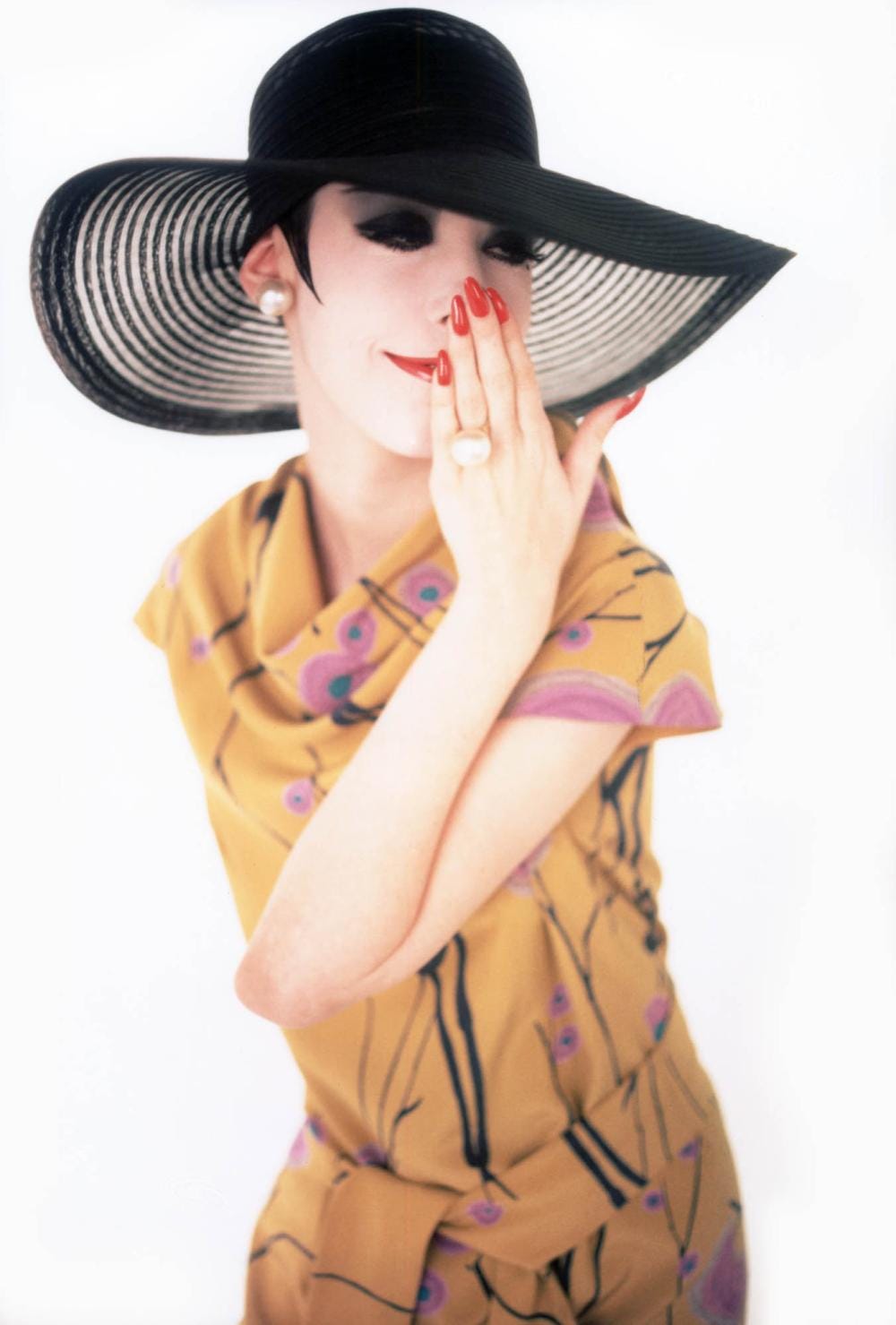
Kerry: You don't see many of these silk dresses. She called them her “van Dongen” dresses because she was inspired by the painter. You see, I didn't know who gave the clothes the names—it was Peggy. She gave them the nicknames and that's what they became.
Laura: How did you come to do this auction?
Kerry: I was contacted by Peggy Moffitt's son, Christopher Claxton. He contacted me because there've been lots of exhibitions, dedicated exhibitions of this collection, but he didn't want to go on storing it. A lot of museums already have key pieces, so the only sensible way forward was to have an auction and to allow the world to come and bid and choose what they want. We have a lot of museum interest, but there's also a lot of very wearable items in this sale. I think Peggy would—it’s a shame for them just to be kept in an expensive dark storage where one fears about moths—[like for them to be] let them back into the world, to dance and prance and be performed in again.
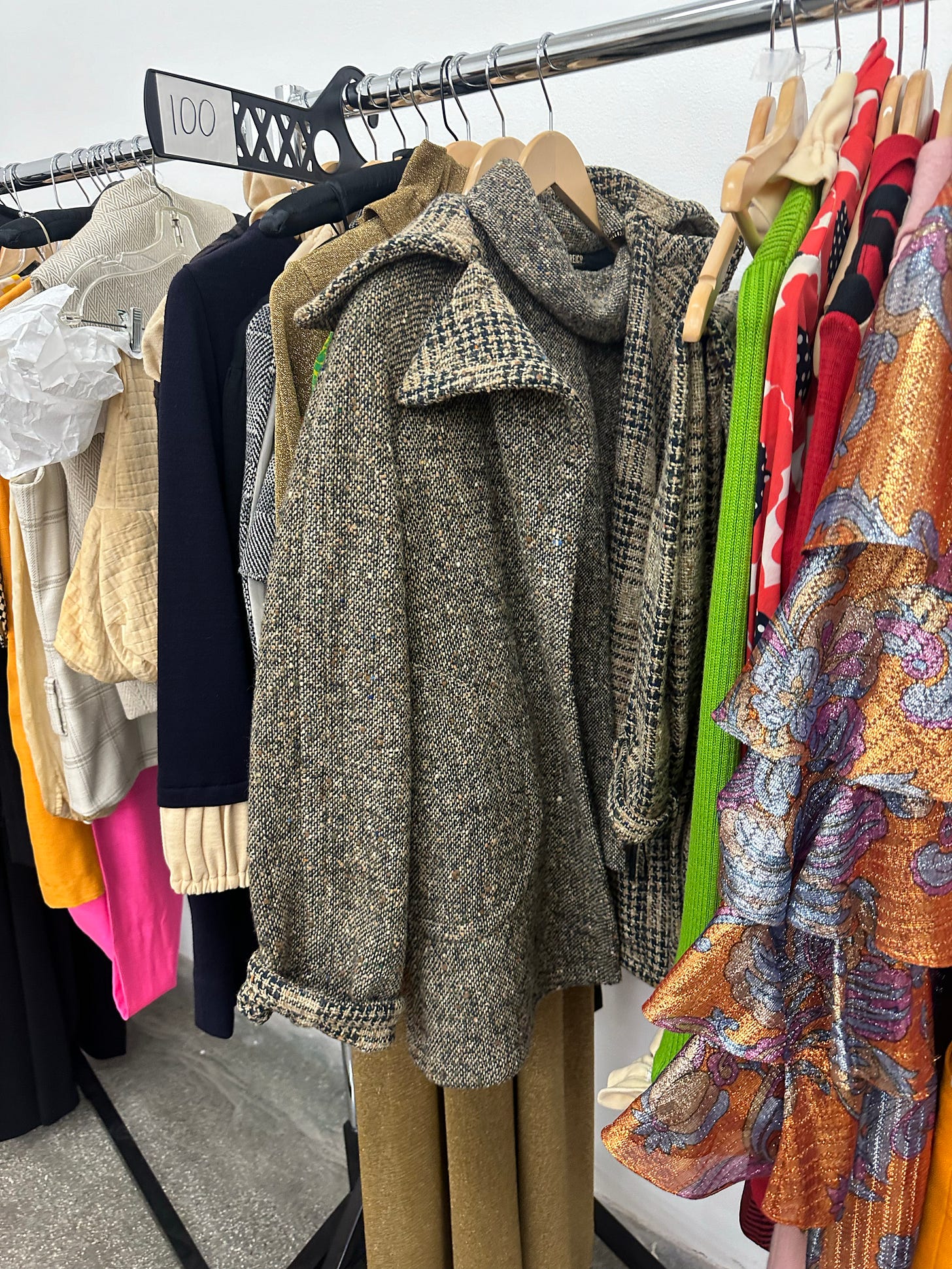
Laura: I met her a few times at different events at LACMA and she was always amazing, dressed in one of these outfits and so full of life. It's nice to think of them going on and having more life, and I like the idea of them going to people who might wear them.
Kerry: I think it's a mixture of both, because there's enough for everyone here. The thing is about these, there are lots of Rudi Gernreich outfits out there in the world still, but these are Peggy Moffitt’s. A lot of them appear in the book as well, in The Rudi Gernreich Book.
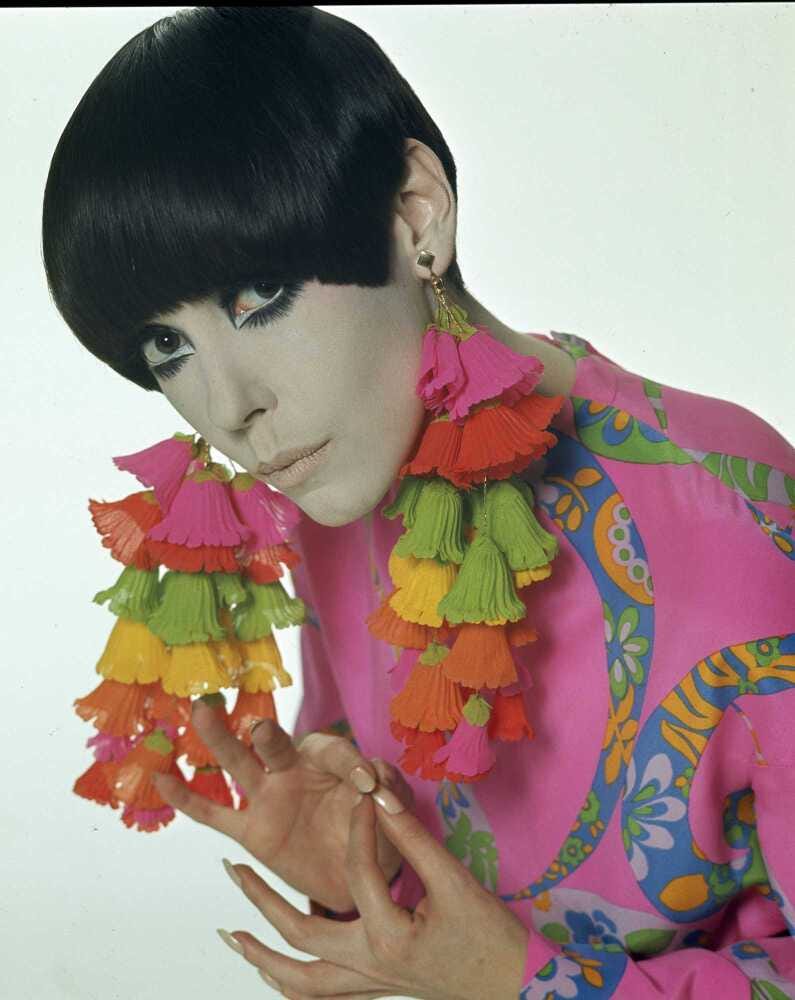
Laura: When you look at them, you're like, "Okay, I know that picture." I know exactly the picture of her in this outfit or that one and where it was published, so it’s really wonderful to see and feel the actual pieces she wore in such iconic images.
Why did you decide to open a showroom in America?
Kerry: I've been looking. I've got so many buyers and people wishing to sell with me. We are a worldwide-known brand now—we try to do the best sales of historic fashion in the world. That's our aim. We care, we love the things we do. I've been looking in America for a long time and I could never find the right place that was: A. affordable, and B. safe and accessible.
I found this wonderful building called Mana Contemporary. I'm surrounded by artists, sculptors, photographers, fashion designers, and it's a beautiful space. It's completely secure. It's so well run. It's a delight to work in it, basically. I know because I'm traveling between—we have sales in London, we have sales in Paris, I do business getting in Europe, I have business getting in America—I'm always constantly on the go and it’s very important for me that I know that my clothes, that they're guarded, they're safe and secure, and they are here. It's all so beautifully run, beautifully kept, this building, and it's completely safe.
Laura: How often do you plan to do auctions in New York?
Kerry: I'm going to be doing single-owner sales initially because I think I don't have the bandwidth to cope with a hundred different vendors in one auction with one thing. It's just too much. At the moment, we're concentrating on single owners, and I've got a couple more in the pipeline, as and when they come through. This is the first. We're testing everything out today and tomorrow, making sure all the IT works, all the phones work, all that kind of thing. It's a bit nerve-wracking. But once that's done, we have a lovely setup here. We have a great photographic studio upstairs. We have everything we need. All we need is the clothes.
Laura: Fantastic. It's amazing to watch, because I probably first bought from you maybe 20 years ago, how much the vintage auction market has changed since then.
Kerry: It has. I've always been in it; I've always loved it. I've been in this business for 45 years, so a lot of the people who were collecting then, perhaps, might wish to sell now, and I'm a trusted pair of hands, I would say, because we pride ourselves on doing research, we guarantee everything we sell. If there's an archive image, we add it, we do footnotes. It's not, "Here's a load of clothes and we're flogging them." It's not that. It's never been that. Even when vintage fashion was making not very much money, I still did it because I loved it. That's why our sales in London, our fine sales, we call them “Passion for Fashion,” because that's what we have, and that's what our buyers have.
Laura: I always love getting your emails talking through the key items in each sale—particularly the older things, the depth of research into them is amazing.
Kerry: Oh, thank you. We’ve had an amazing start to the year and end of last year because in December in Paris, we had the Mouna Ayoub collection of Jean Paul Gaultier haute couture. We then had “Martin Margiela, the Early Years: 1988-94,” which was incredible. Each of these was making over €1 million at a time. Then we had, in January, we had “Empire of Fashion,” which is just Regency so it's from 1796 to 1820, roughly. That, I was very concerned about because there were an awful lot of long, white, muslin dresses. That made a million, just under, against a £200,000 estimate.
I think people trust us. A lot of people never, ever come to Kerry Taylor Auctions. In fact, here, I've seen people—they've just been names to me, telephone bidding, placing bids, sending their things—and now getting to meet them, which is wonderful. I think we're trusted. People don't necessarily have to come and view, but if you can come and view, we do lovely exhibitions, and they're fun. We had about 1,000 people through on Saturday.
Laura: Amazing. Do you find that it is mostly institutions buying now, or is it mostly collectors?
Kerry: For the very expensive lots, it's institutions and mega-rich women, who in the past gone via stylists or they've gone via well-known dealers, but they see how easy it is just to register to bid, pick up a phone, and say, "Bid, bid." "Do you wish to bid?" "Yes, bid." Sometimes we get world records because you get a really feisty woman, and she's not giving into that museum, no way, and the museum's not giving into the feisty woman, so it makes for very exciting auctions.
We never know what's going to happen. Sometimes the things you predict are going to sell well, they do okay, and there'll be something that is quirky… For example, Lot 52, I love the photograph of Peggy wearing this. It's printed in orange, pink, and ivory satin, and it's by a crazy American designer who I love, a fabric designer called Tzaims Luksus. You see, something like that, no one else has. A lot of institutions already have things, perhaps from “Basic Black,” or they might have a monokini, but they won't have that. That's the only one I know, because Rudi did make things as one-offs for Peggy. They didn't go into production, and I'm going to be excited when that one comes out. I love it.
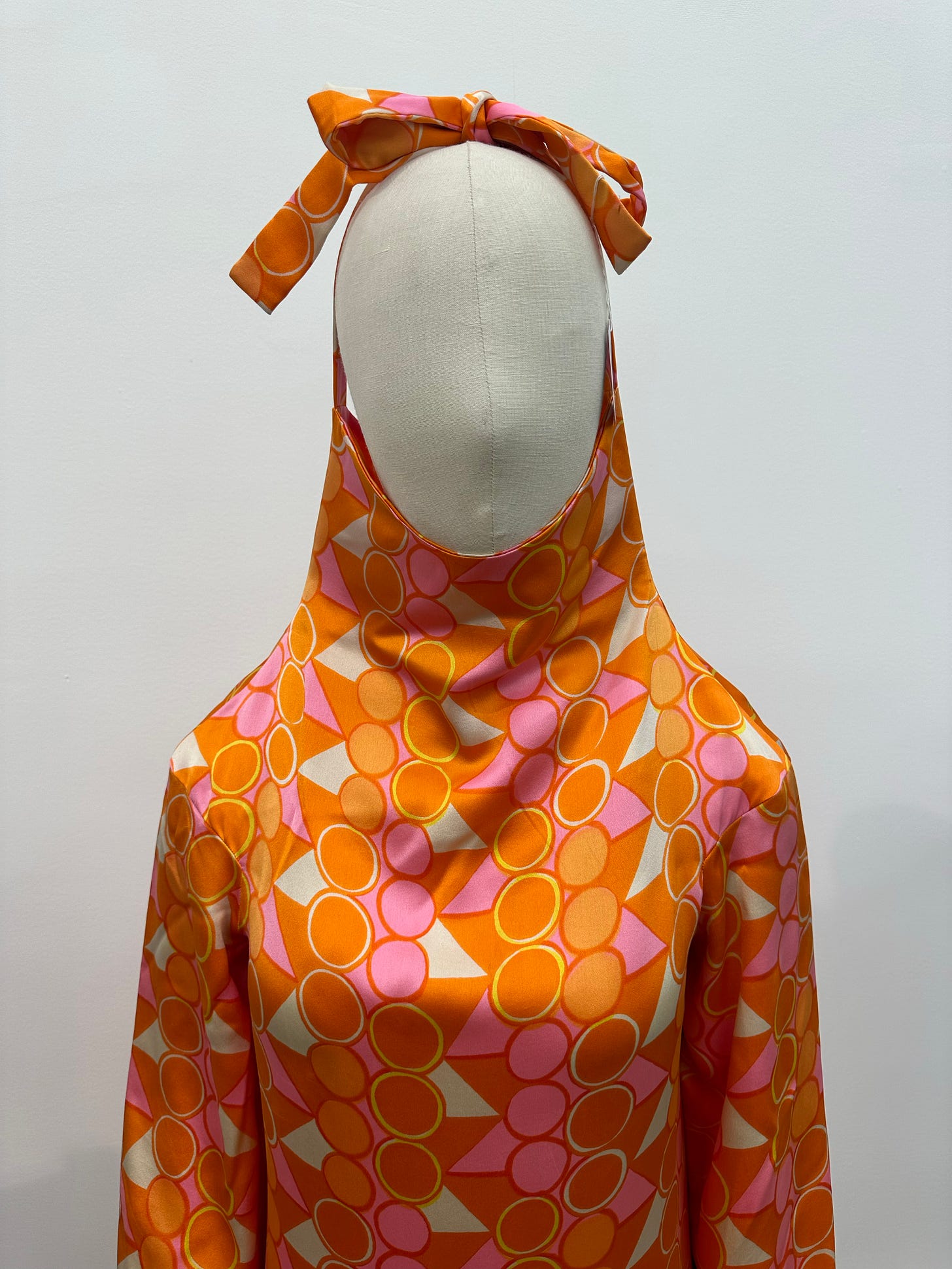
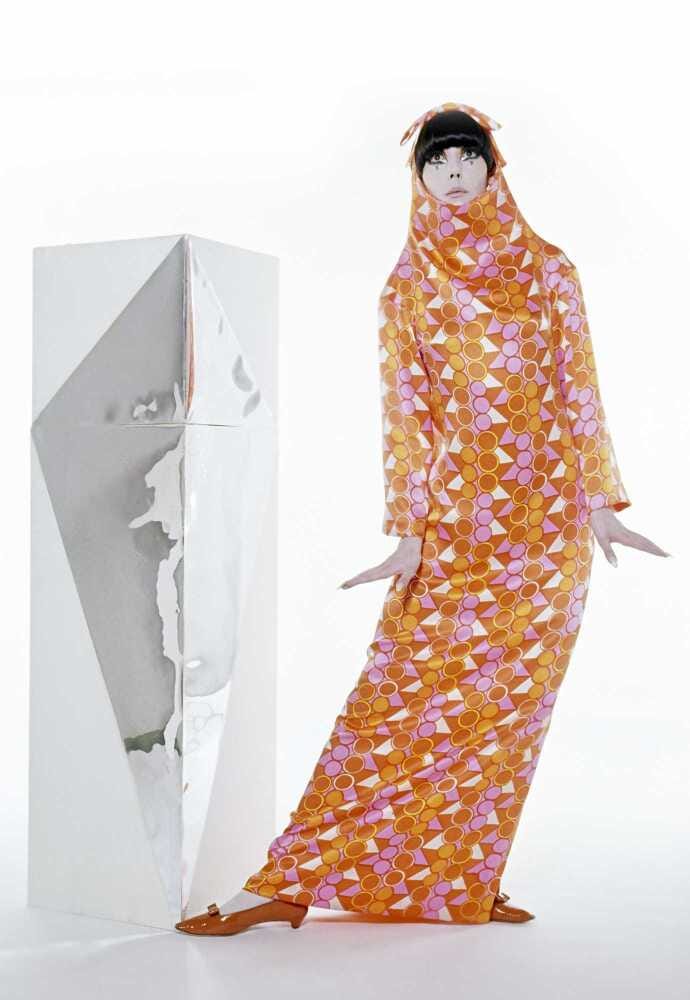
Interviewer: I love that one too. So good. Are the shoes all hers?
Kerry: Some of them are props. Those are props. The tiger ones are real. These little black mules are real, and with the kabuki dress, again, they're the ones that she's photographed wearing. It took me ages to match up all the shoes to match the clothes and earrings to match the clothes. Where I knew something should go with something, it's with that item. We've taken great care.
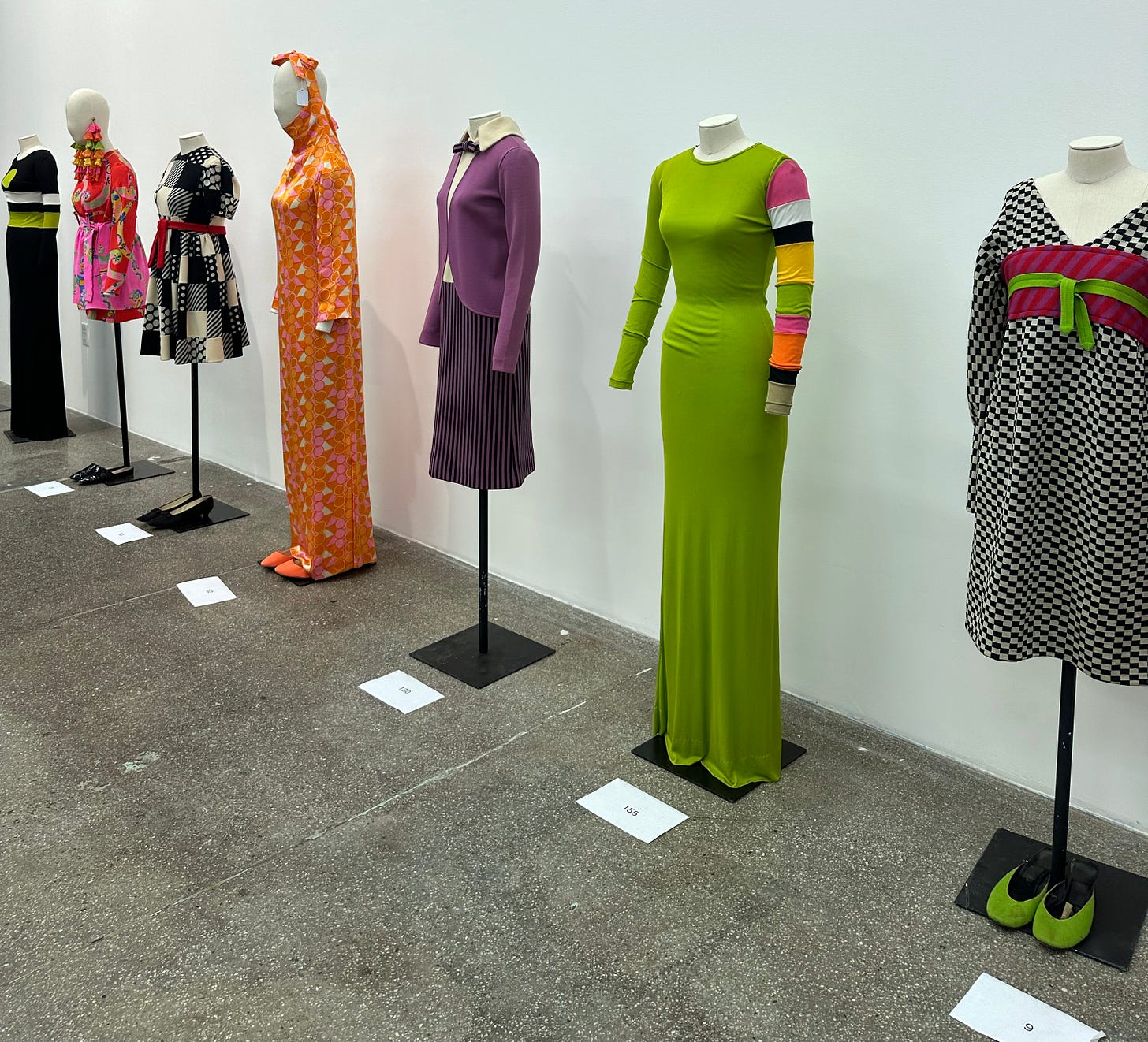
I would like to think that if Peggy walked in, she wouldn't say, "Kerry, that's wrong." She'd say, "Okay. Fairly good job, Kerry." Maybe she'd say that because we have tried incredibly hard to do justice to what is basically her life's work and Rudi Gernreich's work, so beautifully documented by Bill Claxton.
Laura: There are some other designers in her collection as well, right?
Kerry: There's one Norell—a lovely little black Norell. Her wedding dress in 1959 was made by Gustav Tassell, which is haute couture finish. And we have the pink and black, mad mod art Pierre Cardin dress from 1965, which she probably picked up when she did a bit of modeling for him when she went to Europe—she went to London and then to Paris. She appeared in the film Blow-up with David Hemmings, and there's actually another dress that she wore in that film. The one next to it is beautiful because that's Givenchy haute couture. She must have charmed Mr. Givenchy because this is from his Autumn/Winter 1960/61 collection. She always called it her Breakfast at Tiffany's dress because it is from that same collection. It’s the cocktail version. The skirt's padded to give it that extra luxurious handle.

Laura: So beautiful. How long did it take your team to put it all together? You have so many auctions going one after another.
Kerry: It was hard. Because I'd done a lot of the research before I came, it took me probably about 10 days with my colleague, Julia, who was helping, because we have the online sale as well as the live. It was hell for leather. I had to come back a second time, because, unfortunately, a box was misplaced in transit, and that was a bit heart-stopping. They did find it, but I had to fly back so I had another chance to look at everything again and put together the complete looks because there's no point having a complete look when you're missing half of it. When I'm here, I do work a minimum 12-hour day, but I can work a 16-hour day. Anyone who knows me knows it's true, I do nothing but catalogue work, even when I go home, I'm working, I'm updating, checking, but I love it, so it's not really work to me. I do get quite tired sometimes. I'm getting on these days, but I do enjoy it, so I can't complain.
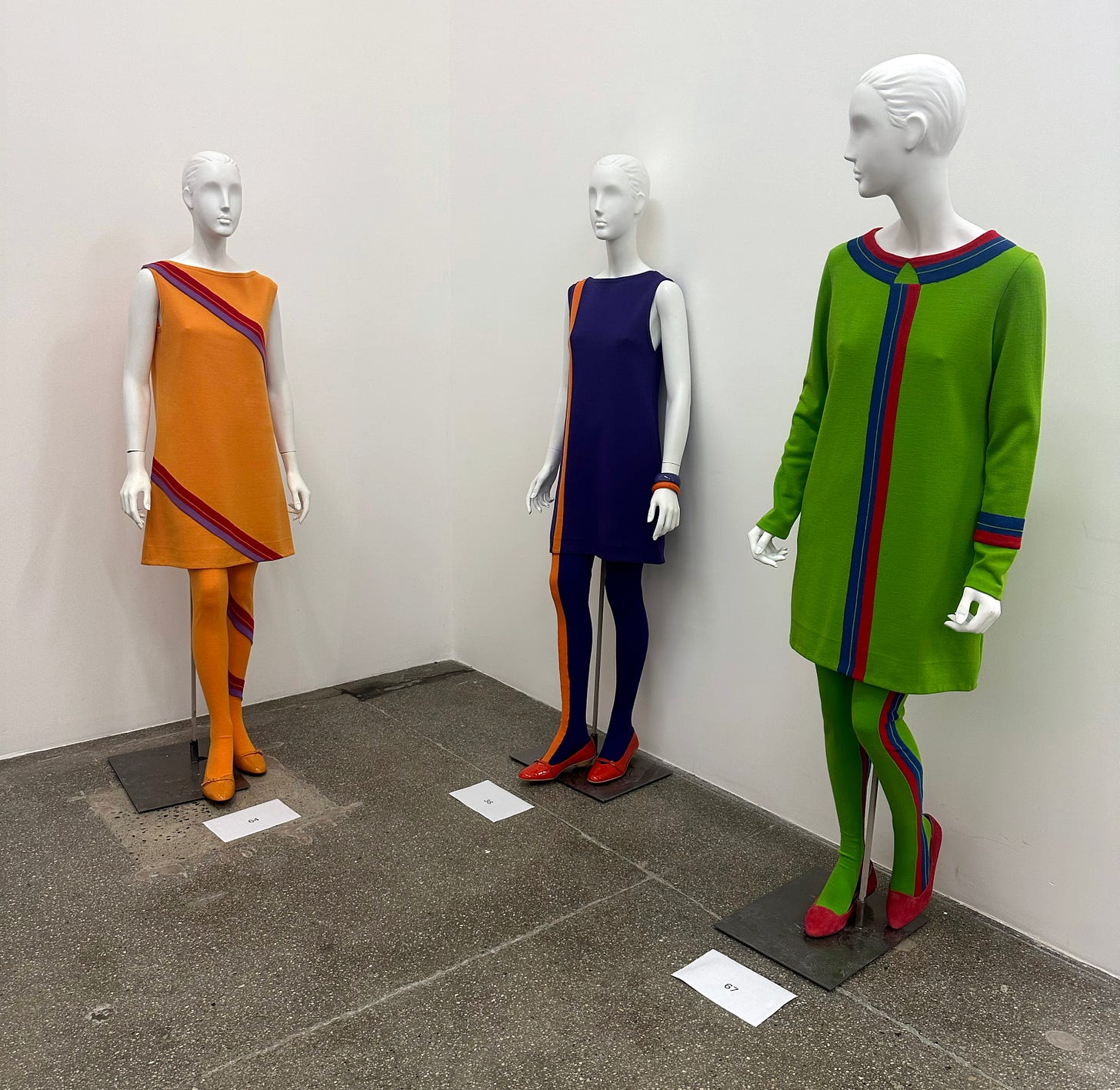
It would have broken my heart if this had gone to someone else, if this had gone to some other auction house, just flogging it as if it's meat and potatoes or whatever—they didn't really love it or care about it or go to the Nth degree to put the things together as they should be and date them correctly and make sure the photographs all match. It would have broken my heart. We've done our best, so it's now up to all the buyers out there to let us know if they appreciate it. Let's hope that these wonderful things find new homes.
Laura: Just the fact that you've got a thousand people to come through and see everything in one day, that’s remarkable.
Kerry: Yes, but the proof of the pudding is in the eating. When the gavels fall, that's when we know what's going to happen.
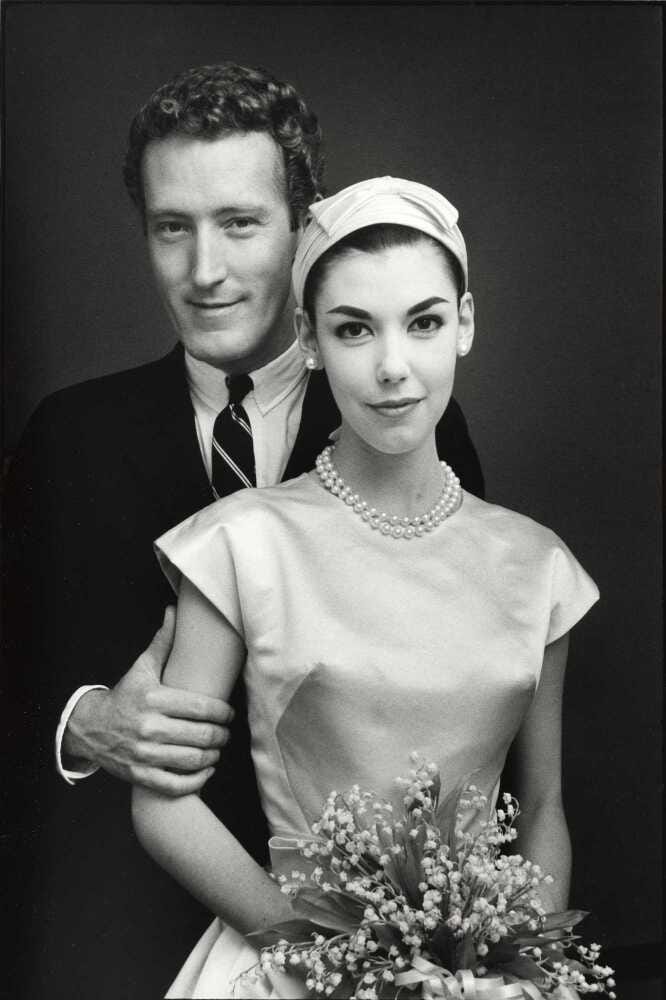
But if we look at her wedding dress by Gustave Tassell, all this hand finishing. He was really good. American design, it's one of these things which is still affordable and still quite underrated. What we need is a really big American collection to get everyone excited again, perhaps.
Laura: When I look at all of these clothes, I feel like they're so wearable, easy to wear today. She was amazing.
Kerry: She was. It's a shame people have to grow old, isn't it?
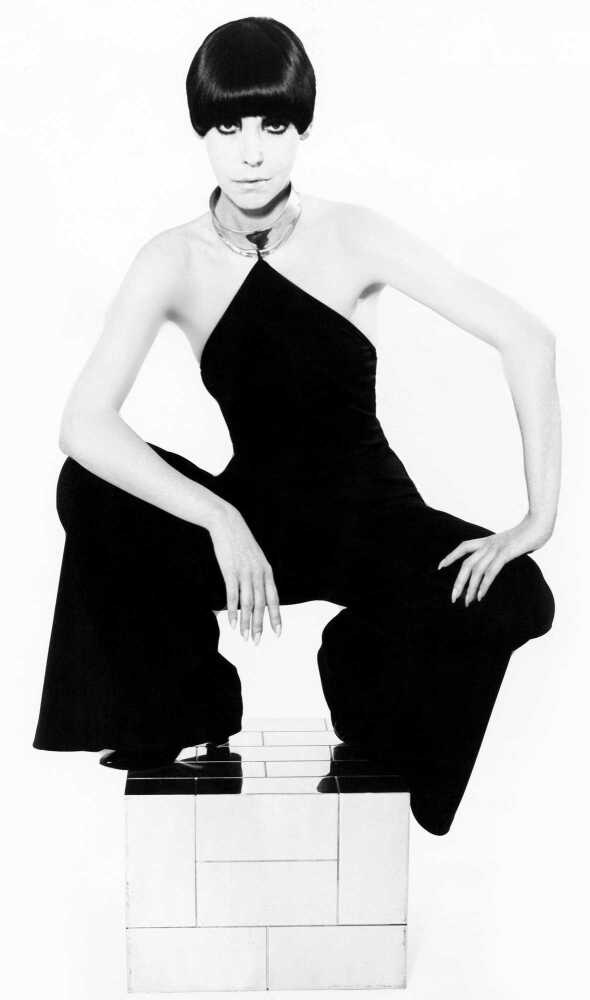
Richard Simmons II: Rudi Gernreich & Simpatico
When I first started researching Richard Simmons, I hadn’t expected that—pre-exercise, pre-fame—he had designed a line of jewelry successful enough to be profiled in newspapers and used by Rudi Gernreich. Whether due to faulty memory or for other reasons, Richard rewrote when and how this fits into his history.
















